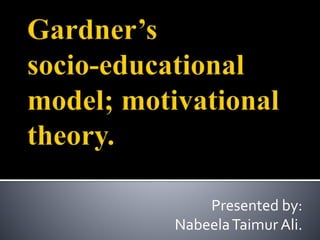
Gardner’s socio educational model.
- 2. Gardner’s socio- educational model, with its major modifications made all over the years and his latest version of the theory.
- 3. MOTIVATION The definition of motivation is very complex. It is multi- faceted, involving affective, cognitive and behavioral elements. Kleinginna (1981) presented 102 statements referring to the term. A simple definition is not possible. Gardner (1985) in defining motivation argues that four elements must be present for a student to be considered motivated: a goal, desire to achieve the goal, positive attitudes and effort. Gardner has referred to these as “affective variables”, differentiating them from the cognitive aspects usually associated in the language learning, as intelligence, aptitude and related variables.
- 4. BACKGROUND. Gardner’s interest in the individual differences variables in second language acquisition started in 1956. At that time, he was a new graduate student in Psychology and talked to his thesis advisor, W.E. Lambert, who was doing research on Bilingualism, about possible thesis topics. After discussing some possibilities, Gardner said that he “didn’t see how someone could really learn a second language, if they didn’t like the group who spoke the language” and then Lambert exclaimed that he found out his thesis.
- 5. Gardner started developing his socio-educational model depicting the attitudes and motivation in second language learning in the 1960s and has continued revising it. It was last revised in 2001. The model proposes that there are two primary individual differences variables in language learning: ABILITY and MOTIVATION Students with higher levels of ability (intelligence and language aptitude) will tend to be more successful at learning the language than the students who are less “endowed”. Students with higher levels of motivation will do better than the students with lower levels.
- 6. The formal contexts refers to any situation where instruction is realized (the language classroom). •Motivation n ability will be equally involved. informal contexts are any other situation where the language can be used or experienced (i.e. listening to the radio, watching movies, the street, etc). •Motivation will be more involved. •Motivation determines if the individual takes part in informal context. The factors are expected to be relatively independent because some students high in ability may be high or low in motivation and vice-versa. In the model, both ability and motivation are related to the formal and informal language learning contexts. Both contexts lead to linguistic n non-linguistic outcomes
- 7. Gardner’s 1979 model presented four variables Social milieu Individual differences Settings Outcomes These FOUR are inter- related when acquiring a language.
- 8. The first variable, social milieu refers to the individual’s cultural beliefs or environment and it plays a role as influencing both affective and cognitive individual differences among language learners.
- 9. The second variable, INDIVIDUAL DIFFERENCES includes four sub-variables (two cognitive and two affective factors) LANGUAGE APTITUDE (verbal and cognitive abilities) SITUATIONAL ANXIETY (it is seen as an inhibiting effect on the learner’s performance in acquiring a second language). MOTIVATION how hard the learner will work to acquire the second language) INTELLIGENCE (a determiner of how quick and how well the learner will acquire the language).
- 10. The third variable, LEARNING ACQUISITION CONTEXTS, refers to the setting where the language is being learned, the combination of formal language training and informal language experience.
- 11. INCLUDES LINGUISTIC KNOWLEDGE AND LANGUAGE SKILLS vocabulary knowledge, grammar, fluency, pronunciation, etc. NON- LINGUISTIC SKILLS These are seen as the individual’s attitudes and values regarding the beliefs or cultural values of the target language community. THE FOURTH VARIABLE: LANGUAGE LERNING OUTCOME
- 12. Gardner (1985) modified the model by introducing the concept of integrative motive within the individual differences variable. Divided in two components: attitudes toward the learning situation and integrativeness.
- 13. Attitudes toward the learning situation involve attitudes toward the school, reactions to the textbooks, evaluation of the language teacher and the language course etc. Clearly, the nature of the learning situation will influence a student’s motivation. Integrativeness is seen as an interest in the second language group, the learner shows an openness and identification with the target language community and their culture. Gardner (2005) states that “individuals for whom their own ethno-linguistic heritage is a major part of their sense of identity would be low in integrativeness; those for whom their ethnicity is not a major component, and who are interested in other cultural communities would be high in integrativeness”. .
- 14. Gardner and Lambert (1959, 1972) have also identified TWO reasons for people to learn a different language. INSTRUMENTAL ORIENTATION: Allows the learner to gain something from acquiring the language, for practical reasons, such as in the case of getting a job or enhancing one’s education. INTEGRATIVE MOTIVE: An ability to relate to the language of a community different than yours and it represents an interchange between “self- concept, attitudes and motivation”.
- 16. CRITICISM OF GARDNER’S SOCIO- EDUCATIONAL MODEL Initially Au (1988) and Oller (1981) criticized his conceptual and operational definitions based on inconsistencies, when discussing the impact of attitudes / motivation on language achievement. In the early 1990s, three papers were published that were critical of Gardner’s socio- educational model. The critics intended to expand the socio-educational model and include additional motivational variables.